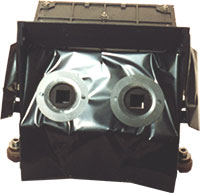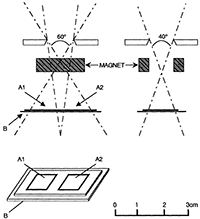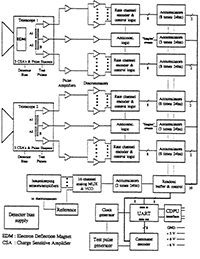LION (Low Energy Ion and Electron Instrument)

- Figure 0: The COSTEP sensor unit LION
LION is provided by the St. Patrick's College, Maynooth, Ireland.
LION Sensor

- Figure 1: LION telescope 2 schematics, top: two views of the aperture, the deflection magnets, and the detector stack - rotated through 90° bottom: perspective view of the detector stack. Telescope 1 (not shown) without magnet, otherwise identical.
LION is a stack of semiconductor detectors to measure energetic particles. The instrument consists of two sensor heads, each containing a double telescope, which together provide the capability to measure particle spectra in the range 44 keV to 6 MeV for protons and 44 keV to 300 keV for electrons (see Table 1). A channel for Z>1 particles, mainly alphas in the range 7-26 MeV, is also provided. Count rates are accumulated with 15 s time resolution. Fig. 1 shows one of the LION sensors consisting of three ion-implanted silicon detectors arranged in a "2 in 1" telescope configuration. On the top are shown two schematic views - rotated through 90° - of the aperture, the deflection magnets, and the detector stack, while on the bottom a perspective view of the detector stack is given. Square (12 x 12 mm2) detectors A1 and A2 form the dual front elements, making back-to-back contact to the rectangular rear element B (19 x 34 mm2). Detector B is operated in anticoincidence to reduce background from penetrating particles. A1 and A2 view the same rectangular entrance aperture, providing a total field of view of 60° × 40° and a total geometric factor of 0.32 cm2 sr. Each A detector, in combination with the common B detector, forms a distinct particle telescope, providing extended angular coverage for a minimum weight penalty. The LION 2 sensor head employs a "broom magnet", utilizing rare earth NdFeB material to sweep electrons of energies up to at least 300 keV away from both A detectors. In order to eliminate stray magnetic fields, the magnet has a closed soft iron yoke. Higher energy electrons penetrate the A detector and trigger the B detector, thereby enabling their separation from higher energy ions. The LION 1 sensor which is identical, except that no broom magnet is included, measures the sum of electrons and protons, thereby enabling the determination by subtraction of electron rates in the energy range below 300 keV.
| LION 1 Channels | LION 2 Channels | Energy Range |
|---|---|---|
| Table 1: LION Data Channels | ||
| P1 + E1 | P1 | 44 - 80 keV |
| P2 + E2 | P2 | 80 - 125 keV |
| P3 + E3 | P3 | 125 - 200 keV |
| P4 + E4 | P4 | 200 - 300 keV |
| P5 | P5 | 300 - 750 keV |
| P6 | P6 | 0.75 - 2 MeV |
| P7 | P7 | 2 - 6 MeV |
| H1 (alphas) | H1 | 7 - 26 MeV |
Both LION sensor heads and their associated electronics are packed into one housing, having envelope dimensions 18.2 x 15.0 x 13.3 cm3. A sunshade protects the sensor apertures from direct illumination and from stray light. The entrance aperture points in the direction of the nominal interplanetary magnetic field at 1 AU, 45° west of the spacecraft-sun line. The instrument has a total power requirement of 0.9 W; a mass of 2.2 kg an requires a telemetry rate of 40 bits per second.
LION Processing Electronics

- Figure 2: LION functional diagram
The LION analog processing electronics consists of two identical sensor interfaces and a section which performs common functions. The signals of particles that have stopped in one of the 4 front detectors are processed in separate analog chains consisting of two-stage-amplifiers and discriminators. The dynamic range extends from 44 keV to 26 MeV, which is divided into 8 energy bins for counting.
The part comon to both sensors contains a flight test generator to produce test pulses for periodic checking of the analog signal processing chains; a telecommand decoder/buffer to receive and store commands controlling instrument status; an analog housekeeping monitor to select and convert monitored parameters into digital data, and a detector bias voltage supply. A functional block diagram is presented in Fig. 2.
LION Calibration
The discriminator thresholds were calibrated with radioactive sources: Cd-109 (electrons 62.2 and 84.2 keV), Ba-133 (electrons 238, 266, 319, 349 keV), Bi-207 (electrons 482, 554, 972, 1044 keV), and Am-241 (alphas 5.48 MeV). These provide a good coverage of the LION energy range with the well known particle energies, which allowed a precise measurement and adjustment of the thresholds to be made. Special care was taken to match the thresholds of corresponding channels of the sensor with and without magnet in the low-energy range where electron and proton separation is achieved by subtraction. The thresholds for those detectors, which have geometrically the same viewing angle, were adjusted within 1% of the absolute energy value. Table 2 shows the thresholds measurements for the four telescopes, T1 without magnet, T2 with magnet (B=0.3 T), each one containing two detectors D1 and D2.
| T1D1 | Energy Range | T1D2 | Energy Range | T2D1 | Energy Range | T2D2 | Energy Range |
|---|---|---|---|---|---|---|---|
| Table 2: LION threshold calibration | |||||||
| P1 + E1 | 44.5 - 81.9 keV | P1 + E1 | 44.6 - 81.9 keV | P1 | 44.4 - 81.9 keV | P1 | 44.6 - 82.0 keV |
| P2 + E2 | 81.9 - 128.1 keV | P2 + E2 | 81.9 - 127.4 keV | P2 | 81.9 - 128.1 keV | P2 | 82.0 - 128.2 keV |
| P3 + E3 | 128.1 - 189.1 keV | P3 + E3 | 127.4 - 193.5 keV | P3 | 128.1 - 190.1 keV | P3 | 128.2 - 193.9 keV |
| P4 + E4 | 189.1 - 308.9 keV | P4 + E4 | 193.5 - 305.5 keV | P4 | 190.1 - 309.1 keV | P4 | 193.9 - 306.1 keV |
| P5 | 308.9 - 755 keV | P5 | 305.5 - 762 keV | P5 | 309.1 - 754 keV | P5 | 306.1 - 762 keV |
| P6 | 0.755 - 1.99 MeV | P6 | 0.762 - 2.02 MeV | P6 | 0.754 - 1.96 MeV | P6 | 0.762 - 1.97 MeV |
| P7 | 1.99 - 6.04 MeV | P7 | 2.02 - 6.02 MeV | P7 | 1.96 - 6.07 MeV | P7 | 1.97 - 6.01 MeV |
| H1 | 6.87 - 26 MeV | H1 | 6.81 - 26 MeV | H1 | 6.87 - 26 MeV | H1 | 6.85 - 26 MeV |
The behaviour of electrons in the two different sensors of the LION instrument was investigated with electron sources using a special collimator. The energy loss of electrons in the detectors of the magnetic and non-magnetic sensor were measured as a function of position and incident angle. The results will be analyzed and compared with Monte Carlo simulations.
Linearity measurements yielded for each of the eight amplifiers non-linearities of better than 1% in the energy ranges 44 to 307 keV and 0.76 to 6.8 MeV, respectively. The high-gain amplifiers are driven into saturation at about 18 MeV. The highest energy channel, starting at approx. 6.8 MeV, collects Z>1 particles, mainly alphas. For alpha particles the maximum energy loss in the front detector is 26 MeV a maximum incident angle 30°.
The LION pages are based upon
R. Müller-Mellin et. al.
COSTEP - Comprehensive Suprathermal And Energetic Particle Analyser
Solar Physics 162: 483-504, 1995

